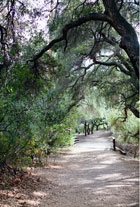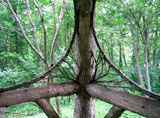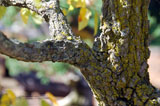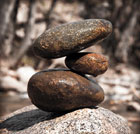Quiet Crow Bonsai
A Collection of Stellar Bonsai MusingsArticles
Wabi Sabi Aesthetic
In the previous segment we discovered the Wabi Sabi Essence. That is to say Wabi and Sabi are two separate words, with related but different meanings. They are brought together only to make a point about aesthetics. We are not born with this aesthetic sensibility. We develop it through long exposure to classical literature, brush painting, poetry and especially bonsai.
Wabi-sabi, as a tool for contemplation and a philosophy of life. It gently promotes a life of quiet contemplation and a gentle aesthetic principle that underscores a meditative approach. Wabi-sabi demotes the role of the intellect and promotes an intuitive feel for life where relationships between people and their environments should be harmonious.
The aesthetic principles of wabi-sabi fall into several categories; of course fine arts like poetry, drama, and literature, have not physical objects, embody these principles in a different way:
Type: The materials used are organic, not synthetic. They are further not to be polished or cleaned or adulterated to appear new or contrived. Hence wood, metal, paper, textiles, stone, and clay comprise acceptable materials which will express the passage of time and whose devolution is expressive and attractive.
Form: The object is shaped naturally or organically, showing natural or intentional asymmetry or irregularity. Form is not imposed by human contrivance but subtly intervenes to make the object follow the capabilities and relevant physical characteristics, properties, and propensities of its own nature. This naturalness of form is probably the first and most striking characteristic of the object. Above all, the work is itself, not a symbol of anything.
Texture: In keeping with the material used, the texture remains rough, uneven, variegated, and random, with every appearance of pursuing an unimpeded natural process.
Beauty: Unlike the Western standard of beauty, Wabi-sabi presses the absolute nature of permeability in the visual and sensual, so that the fragility and poignancy of conventional beauty lost in the passage of time is made real in the present space. The object reveals this different sense of beauty in subtle and even barely perceptible detail, but it is a holistic experience and objects derive their beauty from the emotion conveyed, not from any particular detail of the work.
Color: The object conveys nothing harsh or unnatural, hence colors are muted. Light is diffused or subdued. Colors are derived from natural sources, lacking uniformity or harshness.
Simplicity: Simplicity conveys the spontaneity of natural materials that are not or cannot be embellished. Lack of adulteration and ostentation confirms the authenticity of the work and its conformity to the wabi-sabi spirit.
Space: While sabi works are the objectification of wabi in space, here space refers to proportion and perspective. Nothing is wasted yet there is ample space around the object, conveying a holistic philosophy wherein all elements intertwine and are essential to the whole. Scale becomes an economy of space, but empty space conveys the nature of the universe.
Balance: The work reflects the physical balances found in the natural world. Hence no preconceived formula for symmetry is tenable because nature defines itself by circumstances: a tree grows tall or short, thin or thick, leafy, crooked, etc., in the context of other trees, rocks, water, soil, hummus, etc. in the forest. This balance as circumstance is a design principle for the artist to infuse into a work. The work, like the tree, is unique. The regularity, uniformity, and prescriptions contrived by the artist are secondary to the requirement to reflect a natural and unforced appearance to the object and its context.
Sobriety: Sobriety is the simple principle that art is sometimes better defined by what is left out than by what is put in. Sobriety adds a sense of perspective to the experience of impermanence. The artist approaches creative work with humility, sincerity, and a clarification of motives. Bad motives poison art and inevitably reveal themselves in the work. The artist must proceed to create freely and intimately a personal and vulnerable work that is naturally infused with the spirit of wabi-sabi. Sobriety provides the element of ambiguity because the artist recognizes limitations, and refrains from making bold or emphatic statements.
The art of finding beauty in of things modest and humble begins by adding wabi sabi concepts into your work with trees, may it be in a class or workshop, with your study group or solo. Read More






